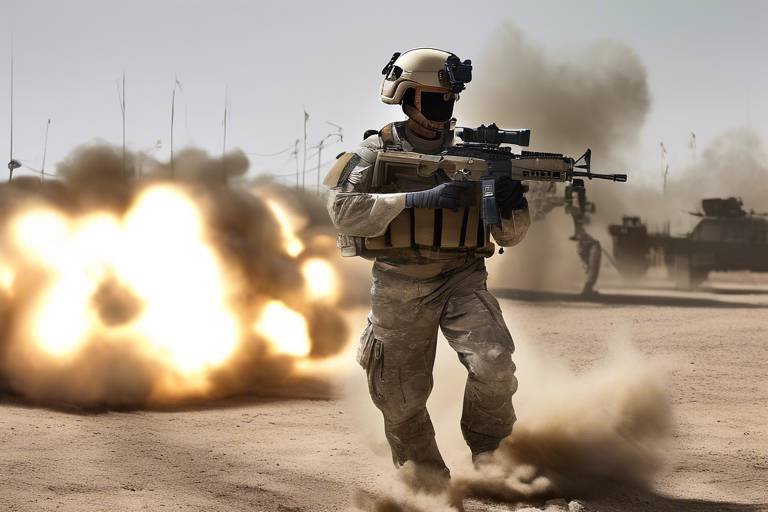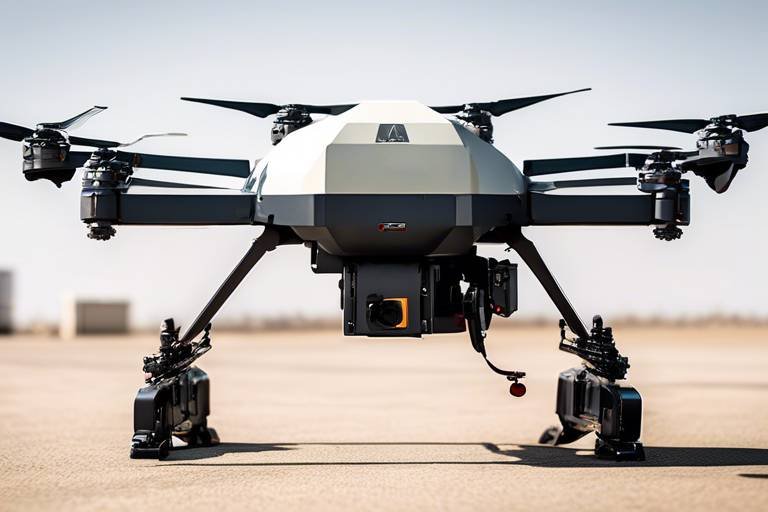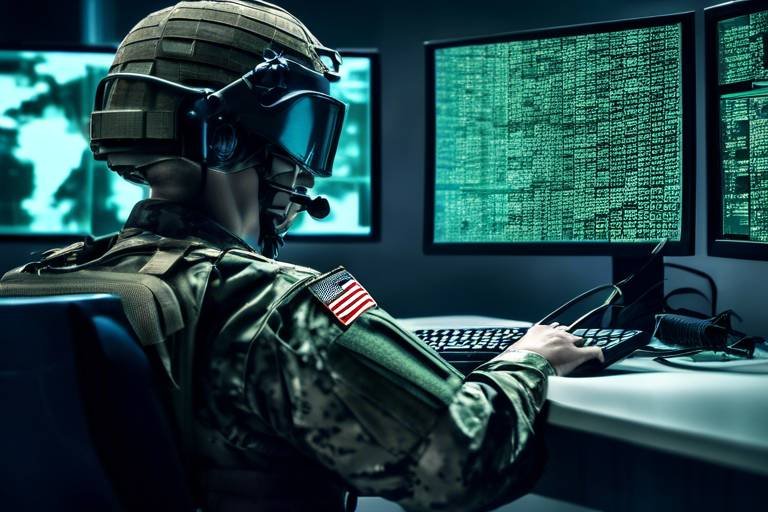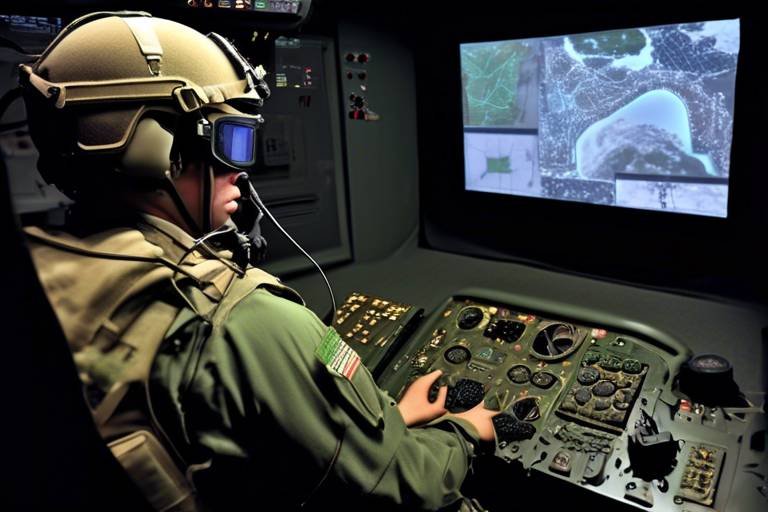How AI is Enhancing Reconnaissance and Surveillance Operations
The world of reconnaissance and surveillance is undergoing a seismic shift thanks to the power of artificial intelligence (AI). Imagine a scenario where vast amounts of data are processed in the blink of an eye, where drones can autonomously scout areas without human oversight, and where every image captured is analyzed for critical insights almost instantly. This isn't science fiction; it's the reality we're stepping into. AI is not just enhancing these operations; it's transforming them in ways we never thought possible. But how exactly is this happening? Let's dive into the details!
AI technologies are revolutionizing how data is collected in reconnaissance. Traditional methods often involve manual data gathering, which can be slow and prone to human error. With AI, data collection is faster, more accurate, and much more efficient. Advanced sensors and automated systems can now gather information from various sources, including satellites, drones, and ground-based sensors, all while minimizing the risk of oversight.
For instance, consider a military operation where intelligence is critical. AI can sift through mountains of data from satellite imagery, social media, and even IoT devices, identifying patterns and anomalies that a human analyst might miss. This capability not only speeds up the intelligence cycle but also enhances the quality of insights gained. The result? Better-informed decisions that can lead to successful outcomes in complex operational environments.
When it comes to surveillance operations, the ability to analyze images and video feeds in real-time is invaluable. AI algorithms are designed to enhance this analysis, allowing for the immediate processing of visual data. This means that security personnel can identify objects, movements, and anomalies as they happen, rather than sifting through hours of footage later. Imagine trying to find a needle in a haystack; AI acts like a magnet, pulling out the important data points and making it easy to spot potential threats.
One of the most talked-about advancements in AI is in facial recognition technology. Powered by sophisticated algorithms, this technology has become increasingly accurate, aiding in the identification of individuals in crowded spaces. Whether it's for security at a major event or monitoring public spaces for safety, facial recognition can quickly flag individuals of interest, enhancing overall security measures.
However, the rise of facial recognition technology brings with it a host of ethical considerations. Privacy issues loom large, as individuals may find themselves surveilled without their consent. Additionally, there are concerns about biases in AI algorithms that could lead to unfair targeting of certain groups. It's crucial to navigate these ethical waters carefully to ensure that the benefits of this technology do not come at the cost of individual rights.
Establishing regulatory frameworks is essential to balance the advantages of facial recognition technology with the need to protect individual rights and privacy. Policymakers must work collaboratively with technologists and ethicists to create guidelines that ensure responsible usage of these powerful tools.
AI systems are also capable of detecting potential threats by analyzing patterns and behaviors. This capability significantly improves response times in surveillance operations. Imagine a security system that can learn from past incidents and adapt its monitoring techniques accordingly. AI can identify unusual patterns, alerting operators to potential threats before they escalate. This proactive approach can be the difference between averted danger and disaster.
The integration of AI with drone technology is another game-changer in reconnaissance capabilities. Drones equipped with AI can efficiently monitor large areas, collecting real-time data from aerial perspectives. This not only enhances situational awareness but also allows for quicker decision-making in critical situations.
Imagine a fleet of autonomous drones conducting reconnaissance missions without human intervention. These drones can navigate complex environments, gather intelligence, and even respond to threats, all while reducing risks to personnel. The operational efficiency gained through this technology is staggering, allowing organizations to allocate resources more effectively and focus on strategic decision-making.
AI also facilitates data fusion techniques, which combine information from various sources to create a comprehensive situational awareness picture. By integrating data from drones, satellites, and ground sensors, operators can gain a holistic view of the operational environment, leading to better-informed decisions and enhanced mission success rates.
Despite its numerous advantages, the implementation of AI in surveillance is not without challenges. Technical limitations can hinder performance, and data privacy concerns continue to be a hot topic. Additionally, the need for skilled personnel to manage AI systems cannot be overlooked. Organizations must invest in training and development to ensure that their teams are equipped to harness the full potential of AI technologies.
- What are the main advantages of using AI in reconnaissance? AI enhances speed, accuracy, and efficiency in data collection and analysis, leading to better decision-making.
- How does facial recognition technology work? It uses algorithms to analyze facial features and match them against databases to identify individuals.
- What ethical concerns are associated with AI surveillance? Privacy issues and algorithmic biases are significant concerns that need to be addressed through regulations.
- Can drones operate autonomously? Yes, AI-equipped drones can perform reconnaissance missions without human intervention, increasing operational efficiency.

The Role of AI in Data Collection
Artificial Intelligence (AI) is not just a buzzword; it’s a game changer in the realm of data collection for reconnaissance and surveillance operations. Imagine a world where gathering information is not only faster but also more precise—this is the reality that AI is creating. With the advent of advanced sensors and automated systems, AI technologies are revolutionizing how data is collected. Traditional methods of data gathering often involved tedious manual processes, but AI streamlines these operations, allowing for a seamless flow of information.
One of the most remarkable aspects of AI in data collection is its ability to process vast amounts of data from various sources in real-time. Think of it as having a super-intelligent assistant who can sift through mountains of data and pinpoint exactly what you need. This capability is particularly beneficial in reconnaissance missions where time is of the essence. AI systems can rapidly analyze data from satellite imagery, drones, and ground sensors, providing actionable intelligence in a fraction of the time it would take human analysts.
Moreover, AI enhances the accuracy of data collection by minimizing human errors. When humans are involved, there’s always the potential for oversight, fatigue, or bias. AI, on the other hand, operates on algorithms that can be continuously refined and improved. This leads to a more reliable data collection process, which is crucial for making informed decisions in high-stakes situations. For instance, AI can identify patterns and anomalies in data that a human might overlook, ensuring that no critical information slips through the cracks.
In addition to speed and accuracy, AI also enables the integration of various data types. For example, it can combine visual data from cameras with audio data from microphones, creating a more comprehensive understanding of a situation. This multifaceted approach to data collection allows for a richer context, which is essential for effective surveillance operations. To illustrate, consider the following table that highlights different data sources and their integration:
| Data Source | Type of Information | AI Application |
|---|---|---|
| Satellite Imagery | Geospatial data | Pattern recognition, object detection |
| Drones | Aerial footage | Real-time analysis, area monitoring |
| Ground Sensors | Environmental data | Data aggregation, anomaly detection |
| Social Media | Public sentiment, real-time updates | Trend analysis, predictive modeling |
As we delve deeper into the role of AI in data collection, it’s clear that these technologies are not just enhancing existing methods; they are redefining the entire landscape of reconnaissance and surveillance. The ability to gather and analyze data swiftly and accurately can mean the difference between success and failure in critical operations. But it’s not just about collecting data; it’s about transforming that data into actionable insights that can guide decision-making processes.
In conclusion, the role of AI in data collection is monumental, paving the way for more efficient, accurate, and comprehensive reconnaissance and surveillance operations. As we embrace these technologies, the potential for improved operational efficiency and effectiveness becomes limitless.
- How does AI improve data accuracy in surveillance?
AI minimizes human error by utilizing algorithms that can analyze data consistently and accurately, leading to more reliable results. - What types of data can AI collect?
AI can collect a wide range of data types, including satellite imagery, drone footage, environmental data from sensors, and even social media data. - Can AI operate independently in data collection?
Yes, AI systems can function autonomously, collecting and analyzing data without human intervention, which increases efficiency and reduces risks.

Improved Image and Video Analysis
In today's fast-paced world, the demand for rapid and precise information has never been higher. Enter artificial intelligence, a game-changer in the realm of image and video analysis. Imagine a scenario where surveillance footage is processed in real-time, allowing security personnel to respond to incidents as they unfold. This is not science fiction; it’s the reality brought forth by AI technologies. With advanced algorithms, AI can sift through countless hours of video, identifying critical information that would take humans days or even weeks to analyze.
At the heart of this transformation are sophisticated computer vision algorithms that empower machines to interpret visual data much like a human would. These algorithms are designed to recognize patterns, detect movements, and identify objects with remarkable accuracy. For instance, in a crowded public space, AI can quickly pinpoint unusual behavior, such as someone loitering or acting suspiciously, and alert security teams instantly. This capability not only enhances safety but also optimizes resource allocation in surveillance operations.
Moreover, the integration of machine learning techniques allows AI systems to improve over time. They learn from past data, making them more adept at recognizing potential threats and anomalies. This continuous learning process is akin to training an athlete; the more they practice, the better they become. As a result, the accuracy of image and video analysis is constantly on the rise, leading to more effective surveillance strategies.
To illustrate the impact of AI on image and video analysis, consider the following table that summarizes key advancements:
| Advancement | Description | Benefits |
|---|---|---|
| Real-Time Processing | AI analyzes video feeds instantly. | Immediate threat detection and response. |
| Object Recognition | Identifies and categorizes objects in footage. | Enhanced situational awareness. |
| Behavior Analysis | Monitors and interprets human actions. | Proactive security measures. |
| Anomaly Detection | Flags unusual patterns in data. | Reduces false alarms and improves accuracy. |
As we look towards the future, the potential for AI in image and video analysis seems limitless. By harnessing the power of AI, organizations can not only enhance their surveillance capabilities but also create safer environments for everyone. However, with great power comes great responsibility. It is crucial to address the ethical implications of such technologies, ensuring that they are used responsibly and transparently.
- How does AI improve video surveillance?
AI enhances video surveillance by enabling real-time analysis, object recognition, and behavior detection, allowing for quicker responses to potential threats. - What are the ethical concerns surrounding AI in surveillance?
Concerns include privacy issues, potential biases in AI algorithms, and the need for transparency in how surveillance data is used. - Can AI systems learn from previous data?
Yes, AI systems utilize machine learning to improve their accuracy and effectiveness over time by learning from past data and experiences. - What role does data privacy play in AI surveillance?
Data privacy is crucial as it ensures that individuals' rights are protected while still benefiting from advanced surveillance technologies.

Facial Recognition Technology
Facial recognition technology, powered by advanced artificial intelligence, has emerged as a game-changer in the realm of surveillance. Imagine walking through a crowded city street, and a system can identify individuals in real-time, enhancing security measures and improving public safety. This technology uses complex algorithms to analyze facial features and match them against a database of known faces. The accuracy of these systems has significantly improved, making them invaluable tools for law enforcement and security agencies.
At the heart of facial recognition lies a sophisticated process that involves several key steps:
- Image Acquisition: Capturing images or video feeds from various sources, such as CCTV cameras or drones.
- Face Detection: Identifying and isolating faces within the captured images.
- Feature Extraction: Analyzing unique facial features like the distance between the eyes, nose shape, and jawline.
- Matching: Comparing the extracted features against a database to find potential matches.
This technology has not only improved the efficiency of surveillance operations but has also opened up new avenues for public safety. For instance, during large events such as concerts or sports games, facial recognition can help identify potential threats or locate missing persons quickly. However, while the benefits are substantial, the technology is not without its challenges.
One of the primary concerns surrounding facial recognition technology is the potential for privacy violations. The ability to track individuals without their consent raises ethical questions that society must address. Additionally, there are concerns about the accuracy of these systems, particularly regarding bias. Studies have shown that some facial recognition algorithms perform poorly on individuals from certain demographic groups, leading to unfair targeting and potential discrimination.
To mitigate these issues, it is crucial to establish a comprehensive regulatory framework that governs the use of facial recognition technology. This framework should aim to balance the benefits of enhanced security with the need to protect individual rights and privacy. Implementing guidelines for transparency, accountability, and oversight can help ensure that facial recognition is used responsibly and ethically.
In conclusion, while facial recognition technology holds immense potential for improving surveillance operations, it is essential to navigate the accompanying ethical and regulatory challenges carefully. As we continue to advance in this field, society must engage in open dialogues about the implications of such technologies, ensuring that we harness their power while protecting the rights of individuals.
- What is facial recognition technology?
Facial recognition technology is a biometric system that uses algorithms to identify or verify a person’s identity by analyzing facial features from images or videos.
- How accurate is facial recognition technology?
The accuracy of facial recognition technology has improved significantly, but it can vary based on factors such as lighting, angle, and the demographic characteristics of individuals.
- What are the privacy concerns associated with facial recognition?
Privacy concerns include the potential for unauthorized surveillance, tracking individuals without consent, and the risk of data breaches that expose personal information.
- How can we ensure ethical use of facial recognition technology?
Establishing regulatory frameworks, promoting transparency, and implementing oversight mechanisms can help ensure that facial recognition technology is used ethically and responsibly.

Ethical Considerations in Facial Recognition
As we dive deeper into the world of facial recognition technology, it’s crucial to pause and consider the ethical implications that accompany its rapid advancement. While this technology holds immense potential for enhancing security and streamlining operations, it also raises significant concerns regarding privacy and bias. Imagine walking down a busy street and knowing that your face is being scanned and analyzed by an AI system—this can feel invasive, right? This feeling of being constantly monitored can lead to a society where individuals feel their every move is under scrutiny.
One of the primary ethical concerns is the issue of privacy. In many cases, individuals may not be aware that their images are being captured and processed. This lack of consent can lead to a feeling of vulnerability and mistrust among the general public. Furthermore, there is the question of how this data is stored and used. Are there safeguards in place to protect this sensitive information from misuse? The answers to these questions are not always clear, and this ambiguity can lead to public outcry and resistance against the technology.
Another pressing issue is the potential for bias in AI algorithms. Studies have shown that many facial recognition systems exhibit significant inaccuracies, particularly when identifying individuals from diverse racial and ethnic backgrounds. This can result in unfair targeting and discrimination, further exacerbating social inequalities. For instance, if an AI system is trained predominantly on images of one demographic, it may struggle to accurately recognize faces from other groups. This raises the question: how can we ensure that these technologies are developed and implemented fairly?
To address these ethical considerations, it is essential to establish regulatory frameworks that guide the use of facial recognition technology. Such frameworks should prioritize individual rights and privacy, ensuring that the benefits of the technology do not come at the expense of personal freedoms. This could involve:
- Implementing strict guidelines on data collection and storage.
- Ensuring transparency in how facial recognition systems operate.
- Mandating regular audits of AI algorithms to identify and mitigate bias.
In conclusion, while facial recognition technology offers exciting possibilities for enhancing security and operational efficiency, it is imperative that we tread carefully. By addressing ethical concerns and establishing robust regulations, we can harness the power of AI in a manner that respects individual rights and promotes fairness in society.
Q: What are the main ethical concerns surrounding facial recognition technology?
A: The main ethical concerns include issues of privacy, consent, and potential biases in AI algorithms that can lead to unfair targeting of individuals.
Q: How can we ensure facial recognition technology is used fairly?
A: Establishing regulatory frameworks that prioritize privacy rights, mandate transparency, and enforce regular audits of AI systems can help ensure fairness in the use of facial recognition technology.
Q: What are the potential consequences of biased facial recognition systems?
A: Biased facial recognition systems can result in inaccuracies in identifying individuals from diverse backgrounds, leading to discrimination and exacerbating social inequalities.

Regulatory Frameworks
The rapid evolution of artificial intelligence (AI) in surveillance and reconnaissance has sparked a crucial conversation surrounding . As AI technologies become more integrated into our daily lives, particularly in security and surveillance, the need for comprehensive regulations is more pressing than ever. These frameworks are designed to ensure that the benefits of AI are harnessed responsibly while safeguarding individual rights and privacy.
At the heart of this regulatory discussion are several key components that must be considered:
- Privacy Protection: Regulations must clearly define how data is collected, stored, and used, ensuring that individuals' privacy rights are upheld. This includes establishing consent protocols for data collection, especially in public spaces.
- Transparency: AI systems should operate transparently, allowing individuals to understand how their data is being used and the decision-making processes of AI algorithms. This transparency builds trust between the public and organizations utilizing AI.
- Accountability: There should be clear lines of accountability for organizations deploying AI technologies. This means that if an AI system makes a mistake or causes harm, there must be mechanisms in place to address the issue and hold responsible parties accountable.
- Bias Mitigation: Regulations should mandate regular audits of AI algorithms to identify and mitigate any biases that may lead to unfair targeting or discrimination. This is particularly critical in applications like facial recognition, where biases can have serious implications.
Furthermore, the regulatory landscape must be adaptable, evolving alongside technological advancements. Policymakers need to engage with technology experts, civil rights organizations, and the public to create a balanced approach that promotes innovation while protecting fundamental rights. For instance, the European Union has been proactive in proposing regulations that specifically address AI's ethical implications, aiming to set a global standard.
In addition to these considerations, international cooperation is essential. AI technologies often transcend national borders, making it vital for countries to collaborate on establishing common standards and practices. This could involve creating bilateral agreements or participating in international organizations focused on AI governance.
In conclusion, while AI holds tremendous potential for enhancing surveillance and reconnaissance operations, it is imperative that we approach its implementation with a framework that prioritizes ethical considerations and individual rights. Without these regulatory measures, we risk creating a society where surveillance becomes pervasive and unchecked, undermining the very freedoms we aim to protect.
- What are the main goals of regulatory frameworks for AI in surveillance?
The primary goals include protecting privacy, ensuring transparency, holding entities accountable, and mitigating bias in AI systems.
- How do regulations impact the development of AI technologies?
Regulations can guide the ethical development of AI technologies, ensuring they are created with societal values in mind while also fostering innovation.
- Are there existing regulations for AI surveillance?
Yes, several countries and regions, like the European Union, are actively developing regulations aimed at governing the use of AI in surveillance.
- What role do international agreements play in AI regulation?
International agreements help establish common standards for AI technologies, facilitating cooperation and consistency in regulations across borders.

Automated Threat Detection
In the ever-evolving landscape of security and surveillance, has emerged as a game-changer. Imagine a system that can analyze vast amounts of data in the blink of an eye, identifying potential threats before they escalate into serious incidents. This is not just a futuristic dream; it's the reality we are stepping into, thanks to the power of artificial intelligence (AI). By harnessing sophisticated algorithms and machine learning techniques, AI systems can sift through mountains of data to detect patterns and anomalies that would be nearly impossible for humans to spot.
One of the most striking features of automated threat detection is its ability to learn and adapt over time. As these systems are exposed to more data, they become increasingly proficient at recognizing what constitutes normal behavior versus what signifies a potential threat. This adaptive learning process is crucial in environments where threats can vary widely, from cybersecurity breaches to physical security risks in public spaces.
Consider a crowded airport, bustling with travelers and activity. An AI-driven surveillance system can monitor video feeds in real-time, analyzing behaviors and movements. If a person starts behaving suspiciously—perhaps lingering too long in a restricted area or making erratic movements—the system can flag this behavior for immediate review by security personnel. This rapid response capability not only enhances security but also helps to prevent incidents before they happen, ensuring the safety of countless individuals.
Furthermore, the integration of AI in threat detection systems can significantly reduce the workload on human operators. Instead of constantly monitoring feeds and data, human personnel can focus on responding to alerts generated by AI, allowing for a more efficient allocation of resources. This symbiotic relationship between humans and machines creates a more effective security apparatus.
However, the implementation of automated threat detection is not without its challenges. There are concerns regarding false positives, where innocent actions may be misinterpreted as threats. Additionally, the reliance on AI raises questions about accountability—who is responsible when an AI system fails to detect a genuine threat? These issues highlight the importance of ongoing human oversight and the need for robust training data to ensure the accuracy of AI algorithms.
To summarize, automated threat detection represents a significant advancement in surveillance technology. By leveraging AI, we can enhance our ability to identify and respond to potential threats in real-time, ultimately creating safer environments. As we continue to refine these technologies and address the challenges they present, the future of security operations looks promising.
- What is automated threat detection? Automated threat detection refers to the use of AI systems to identify potential threats by analyzing patterns and behaviors in real-time data.
- How does AI improve security operations? AI enhances security operations by processing large volumes of data quickly, identifying anomalies, and reducing response times to potential threats.
- Are there risks associated with automated threat detection? Yes, potential risks include false positives, privacy concerns, and the need for human oversight to ensure the system's effectiveness.
- Can automated threat detection be used in various environments? Absolutely! It can be applied in diverse settings, including airports, public events, and cybersecurity frameworks.

Integration with Drone Technology
When it comes to modern reconnaissance, the marriage of artificial intelligence (AI) and drone technology is nothing short of revolutionary. Imagine a bird's-eye view of a vast landscape, where every detail is captured and analyzed in real-time. Drones equipped with AI capabilities are transforming how we monitor and gather intelligence, offering unprecedented efficiency and accuracy. These aerial marvels can cover large areas that would take human operatives days or even weeks to survey, all while providing data that is not only timely but also incredibly detailed.
The integration of AI with drone technology allows for efficient monitoring of environments that are otherwise difficult to access. For instance, in disaster management scenarios, drones can quickly assess damage and locate survivors, relaying vital information to rescue teams within minutes. This capability is not just a matter of convenience; it can be a matter of life and death. As the saying goes, "Time is of the essence," and in emergency situations, every second counts.
Moreover, autonomous drones can perform reconnaissance missions without the need for human intervention. This is a game-changer for military operations, where the risks to personnel can be significantly reduced. Imagine sending a drone into a hostile area to gather intelligence, while the operators remain safely out of harm's way. This not only enhances operational efficiency but also opens up new avenues for strategic planning and execution.
AI-driven drones utilize advanced algorithms that enable them to navigate complex environments, avoiding obstacles and adapting to changing conditions in real-time. This capability is enhanced by data fusion techniques, which allow drones to combine information from various sensors and sources. By synthesizing data from thermal imaging, GPS, and even social media feeds, these drones create a comprehensive situational awareness picture that is invaluable for surveillance operations.
To illustrate the impact of AI on drone technology, consider the following table that highlights key features and benefits:
| Feature | Benefit |
|---|---|
| Autonomous Navigation | Reduces risk to personnel and increases mission efficiency. |
| Real-time Data Analysis | Provides immediate insights for timely decision-making. |
| Data Fusion | Creates a holistic view of the operational environment. |
| Wide Area Coverage | Enables monitoring of large areas in a fraction of the time. |
However, the integration of AI with drone technology is not without its challenges. Issues such as data privacy, regulatory compliance, and the need for skilled personnel to operate and manage these advanced systems must be addressed. As we look to the future, it's clear that the synergy between AI and drones will continue to evolve, offering exciting possibilities for reconnaissance and surveillance operations.
- How do AI-powered drones improve surveillance?
AI-powered drones can analyze data in real-time, allowing for quicker identification of threats and anomalies. - What are the main benefits of using drones in reconnaissance?
Drones provide wide area coverage, reduce risks to personnel, and deliver timely data for decision-making. - Are there ethical concerns with drone surveillance?
Yes, issues such as privacy invasion and data security are significant concerns that need to be addressed.

Autonomous Drones
This article explores the transformative impact of artificial intelligence on reconnaissance and surveillance, highlighting advancements in technology, data analysis, and operational efficiency.
AI technologies are revolutionizing how data is collected in reconnaissance, enabling faster and more accurate gathering of information through advanced sensors and automated systems.
AI algorithms enhance the analysis of images and video feeds, allowing for real-time processing and identification of objects, movements, and anomalies in surveillance operations.
Facial recognition powered by AI is becoming increasingly accurate, aiding in identifying individuals in crowded spaces and enhancing security measures during surveillance.
The use of facial recognition raises ethical concerns, including privacy issues and potential biases in AI algorithms that may lead to unfair targeting.
Establishing regulatory frameworks is essential to balance the benefits of facial recognition technology with the need to protect individual rights and privacy.
AI systems are capable of detecting potential threats by analyzing patterns and behaviors, significantly improving response times in surveillance operations.
The integration of AI with drone technology enhances reconnaissance capabilities, allowing for efficient monitoring of large areas and real-time data collection from aerial perspectives.
Autonomous drones represent a remarkable leap forward in the realm of reconnaissance and surveillance. These unmanned aerial vehicles (UAVs) are equipped with sophisticated AI algorithms that enable them to navigate complex environments without human intervention. Imagine a bird soaring through the sky, effortlessly adapting to changing weather conditions and obstacles while gathering critical data below—that's the kind of freedom and efficiency autonomous drones bring to surveillance operations.
One of the key advantages of autonomous drones is their ability to perform reconnaissance missions over vast areas, reducing the need for human operators to be physically present in potentially dangerous situations. For instance, during disaster response scenarios, these drones can swiftly assess damage, locate survivors, and provide real-time information to emergency responders. This not only saves time but also minimizes risks to human life.
Furthermore, autonomous drones can be programmed to follow specific flight paths or engage in dynamic mission planning, adapting to real-time conditions. They can utilize advanced sensors and cameras to capture high-resolution images and videos, which are then processed using AI to extract valuable insights. This data can be crucial for military operations, border security, and even wildlife conservation efforts.
However, there are challenges to consider. The technology behind autonomous drones must continually evolve to ensure reliability and security. Issues such as signal loss, technical malfunctions, and the potential for hacking pose significant risks. Moreover, as these drones become more prevalent, discussions surrounding regulatory frameworks and ethical considerations will become increasingly important.
In conclusion, autonomous drones are not just a futuristic concept; they are a reality that is reshaping how we approach reconnaissance and surveillance. With the ability to operate independently and gather data efficiently, these drones are paving the way for a new era of operational excellence in various fields.
Despite its advantages, the implementation of AI in surveillance faces challenges, including technical limitations, data privacy concerns, and the need for skilled personnel to manage AI systems.
- What are autonomous drones?
Autonomous drones are unmanned aerial vehicles that can operate without human intervention, utilizing AI for navigation and data collection. - How do autonomous drones improve surveillance?
They enhance surveillance by providing real-time data collection, reducing risks to personnel, and allowing for efficient monitoring of large areas. - What are the risks associated with autonomous drones?
Risks include technical malfunctions, potential hacking, and regulatory challenges concerning privacy and safety. - What is the future of AI in reconnaissance?
The future looks promising, with ongoing advancements in technology and increasing integration of AI in various fields, including military, disaster response, and environmental monitoring.

Data Fusion Techniques
This article explores the transformative impact of artificial intelligence on reconnaissance and surveillance, highlighting advancements in technology, data analysis, and operational efficiency.
AI technologies are revolutionizing how data is collected in reconnaissance, enabling faster and more accurate gathering of information through advanced sensors and automated systems.
AI algorithms enhance the analysis of images and video feeds, allowing for real-time processing and identification of objects, movements, and anomalies in surveillance operations.
Facial recognition powered by AI is becoming increasingly accurate, aiding in identifying individuals in crowded spaces and enhancing security measures during surveillance.
The use of facial recognition raises ethical concerns, including privacy issues and potential biases in AI algorithms that may lead to unfair targeting.
Establishing regulatory frameworks is essential to balance the benefits of facial recognition technology with the need to protect individual rights and privacy.
AI systems are capable of detecting potential threats by analyzing patterns and behaviors, significantly improving response times in surveillance operations.
The integration of AI with drone technology enhances reconnaissance capabilities, allowing for efficient monitoring of large areas and real-time data collection from aerial perspectives.
Autonomous drones equipped with AI can perform reconnaissance missions without human intervention, increasing operational efficiency and reducing risks to personnel.
Data fusion techniques represent a groundbreaking advancement in the realm of surveillance and reconnaissance. By integrating data from multiple sources, AI can create a cohesive and comprehensive picture of the operational environment. Imagine trying to solve a complex puzzle; each piece of data is like a puzzle piece that, when connected, reveals the bigger picture. This technique employs various algorithms and methodologies to synthesize information, ensuring that decision-makers have access to the most relevant and accurate data possible.
One of the key advantages of data fusion is its ability to enhance situational awareness. For instance, when monitoring an area for security threats, data can be gathered from:
- Surveillance cameras
- Drone feeds
- Sensor networks
- Social media platforms
By analyzing this diverse array of information simultaneously, AI can identify patterns and anomalies that might otherwise go unnoticed. For example, if a drone captures unusual movement in a restricted area, AI can cross-reference that data with social media activity to determine if there’s a legitimate threat or if it's simply a harmless event.
Moreover, data fusion techniques can be categorized into two main types: low-level fusion and high-level fusion. Low-level fusion involves combining raw sensor data to create a single, more informative signal, while high-level fusion synthesizes information from different sources to draw conclusions or make decisions. This layered approach ensures that the data processed is not only accurate but also relevant to the specific operational context.
In essence, data fusion techniques empower surveillance operations with enhanced analytical capabilities, enabling faster and more informed decision-making processes. As AI continues to evolve, the potential for these techniques to improve reconnaissance and surveillance will only increase, making them indispensable tools in modern security frameworks.
Despite its advantages, the implementation of AI in surveillance faces challenges, including technical limitations, data privacy concerns, and the need for skilled personnel to manage AI systems.
- What is data fusion in surveillance?
Data fusion in surveillance refers to the process of integrating data from multiple sources to create a unified and comprehensive understanding of a situation or environment. - How does AI improve reconnaissance operations?
AI enhances reconnaissance by enabling faster data collection, real-time analysis, and improved decision-making capabilities based on synthesized information. - What are the ethical concerns associated with AI in surveillance?
Ethical concerns include issues of privacy, potential biases in AI algorithms, and the implications of monitoring individuals without consent. - Can AI completely replace human operators in surveillance?
While AI can significantly enhance operational efficiency, human oversight remains crucial for interpreting data and making complex decisions.

Challenges and Limitations of AI in Surveillance
While the integration of artificial intelligence into surveillance operations offers remarkable benefits, it is not without its challenges and limitations. One of the primary concerns is the issue of data privacy. As AI systems collect and analyze vast amounts of data, the potential for infringing on individual privacy rights increases. People often feel uneasy knowing that their movements and behaviors are being monitored by machines equipped with sophisticated algorithms. This raises the question: how much surveillance is too much?
Moreover, there are significant technical limitations that can hinder the effectiveness of AI in surveillance. For instance, AI algorithms require substantial amounts of high-quality data to function optimally. If the data collected is biased or incomplete, the AI's analysis may lead to incorrect conclusions. This can result in false positives, where innocent individuals are flagged as threats, or false negatives, where actual threats go undetected. The reliability of AI systems is crucial, and any shortcomings can have serious implications for security operations.
Another challenge is the need for skilled personnel to manage and operate these sophisticated systems. While AI can automate many processes, human oversight is still essential. Trained professionals are required to interpret AI-generated data, make informed decisions, and ensure that the technology is functioning as intended. The shortage of qualified personnel in this field can limit the effectiveness of AI in surveillance, as organizations may struggle to find individuals with the necessary expertise.
Additionally, the ethical implications of AI in surveillance cannot be overlooked. There are ongoing debates about the potential for bias in AI algorithms. If these algorithms are trained on data that reflects societal biases, they may perpetuate or even exacerbate existing inequalities. This raises important questions about fairness and accountability in surveillance practices. How can we ensure that AI systems are used ethically and do not discriminate against specific groups?
To address these challenges, organizations must consider implementing robust regulatory frameworks. These frameworks can help establish guidelines for the ethical use of AI in surveillance, ensuring that individual rights are protected while still reaping the benefits of technological advancements. Striking the right balance between security and privacy is crucial in today's digital age.
In summary, while AI has the potential to revolutionize surveillance operations, it is essential to acknowledge and address the challenges and limitations that accompany its use. By focusing on data privacy, technical reliability, skilled personnel, ethical considerations, and regulatory measures, we can harness the power of AI while safeguarding the rights of individuals.
- What are the main challenges of using AI in surveillance?
The main challenges include data privacy concerns, technical limitations, the need for skilled personnel, ethical implications, and the establishment of regulatory frameworks. - How does bias affect AI surveillance systems?
Bias in AI algorithms can lead to unfair targeting and discrimination, as these systems may reflect the biases present in the training data. - Why is human oversight important in AI surveillance?
Human oversight is crucial for interpreting AI data accurately, making informed decisions, and ensuring the technology operates effectively. - What role do regulatory frameworks play in AI surveillance?
Regulatory frameworks help establish guidelines for the ethical use of AI, balancing security needs with the protection of individual rights.
Frequently Asked Questions
- How is AI transforming reconnaissance and surveillance operations?
AI is revolutionizing reconnaissance and surveillance by enabling faster and more accurate data collection, improving image and video analysis, and enhancing threat detection capabilities. With advanced algorithms, AI can analyze vast amounts of data in real-time, making it easier for agencies to respond to potential threats swiftly.
- What role does AI play in data collection for surveillance?
AI technologies utilize advanced sensors and automated systems to gather information more efficiently. This means that data can be collected at a scale and speed that was previously unimaginable, allowing for a more comprehensive understanding of the environment being monitored.
- How does AI improve image and video analysis?
AI algorithms enhance the analysis of images and video feeds by processing them in real-time, allowing for the identification of objects, movements, and anomalies. This capability is crucial for surveillance operations, as it enables security personnel to act quickly on potential threats.
- What are the ethical concerns surrounding facial recognition technology?
The use of facial recognition technology raises significant ethical issues, including privacy violations and the potential for bias in AI algorithms. These biases can lead to unfair targeting of certain individuals or groups, making it essential to address these concerns through regulation and oversight.
- How do regulatory frameworks impact the use of AI in surveillance?
Establishing regulatory frameworks is crucial for balancing the benefits of AI technologies, like facial recognition, with the need to protect individual rights and privacy. These frameworks help ensure that AI is used responsibly and ethically in surveillance operations.
- What is automated threat detection in AI surveillance?
Automated threat detection involves AI systems analyzing patterns and behaviors to identify potential threats. This capability allows for significantly improved response times, as security teams can be alerted to issues before they escalate.
- How does AI integration with drone technology enhance surveillance?
AI integration with drones allows for efficient monitoring of large areas and real-time data collection from aerial perspectives. Autonomous drones can perform reconnaissance missions without human intervention, increasing operational efficiency and reducing risks to personnel.
- What are the challenges of implementing AI in surveillance?
Despite its advantages, implementing AI in surveillance faces challenges such as technical limitations, data privacy concerns, and the need for skilled personnel to manage AI systems. Addressing these challenges is essential for maximizing the benefits of AI in this field.



















